

| ARCHIVE HOME | Sealing Wax Red |
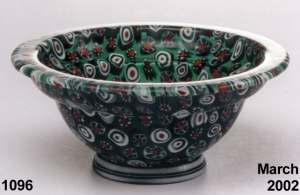 Many original mosaic vessels use opaque red as part of their decoration. It is known as haematinum - 'blood red', although, in fact, there are many different shades of this colour. The colour is caused by cuprous oxide, and the ancient glassmakers had two variations of glass composition with which to produce it. The first used cuprous oxide (c.8%) in a lead-free, soda-lime glass. This produced the darker, duller reds, and was in use from the mid second millenium B.C. The second, in use from the early first millenium B.C., used cuprous oxide (c.10%) in a high lead (15 - 30%) soda-lime glass, and this produced a bright red. There is a sub-division of this type, which used lower values of copper and lead to produce a darker red.
Many original mosaic vessels use opaque red as part of their decoration. It is known as haematinum - 'blood red', although, in fact, there are many different shades of this colour. The colour is caused by cuprous oxide, and the ancient glassmakers had two variations of glass composition with which to produce it. The first used cuprous oxide (c.8%) in a lead-free, soda-lime glass. This produced the darker, duller reds, and was in use from the mid second millenium B.C. The second, in use from the early first millenium B.C., used cuprous oxide (c.10%) in a high lead (15 - 30%) soda-lime glass, and this produced a bright red. There is a sub-division of this type, which used lower values of copper and lead to produce a darker red.
In this newsletter we are focusing on the high copper-high lead haematinum. Much work has been done in recent years to reproduce this glass and to understand its chemistry, but only on an experimental basis, and, until now, the practicalities of using it for glassforming have tended to have been overlooked.
In reproducing bright haematinum, we have had to address two main points, namely the segregation of the glass into areas of increasing concentrations of copper and the formation of relict copper metal at the bottom of the crucible. The approach we have developed is the result of many experiments over the last few years in "glassmaking workshop conditions" as opposed to "laboratory conditions".
The mechanism behind the production of bright red haematinum is the formation and growth of dendritic (branching, root-shaped) cuprous oxide crystals in sufficient size and quantity within the glass matrix. Several variables influence this process:

A more in-depth explanation of the variables governing the growth of cuprous oxide crystals can be found in:
Single stage melts (mixing and melting all the ingredients in one go), even after one takes these points into account, have the problems (noted above) of segregation and relict metal, and we have also encountered these in our experiments. It appears to be very difficult to achieve total integration of these high levels of copper unless the melt is oxidised, in which case one gets a copper blue.
Our process is a two stage melt, combining a red pigment with a colourless base glass. This is the method that has to be used for making lead antimonate yellow as lead and antimony will not combine to form yellow in a single stage melt: instead antimony combines with calcium to form opaque white.
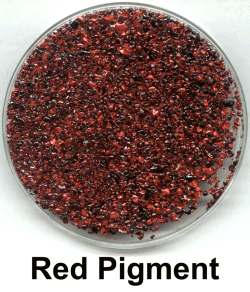
The red pigment is formed in an oxidising process by providing suitable levels of lead, antimony and silicon oxides, together with an oxidising agent such as potassium nitrate, to allow the full conversion of copper metal into cuprous oxide. It can then be combined with the ingredients for a base glass to form an opaque red melt. The ingredients for the pigment are introduced into a crucible in a furnace at 1100°C, and a lid is put on. After c.15mins (for 200gms) a very runny liquid has formed. When poured immediately into cold water, it breaks up into a small grit which is dark orange-red in colour. It is then added to a base batch and melted.
We cannot say that this is how the ancient glassmakers made this red, but it does work. It solves the problems of segregation (even without stirring the glass) and relict metal (there is none).
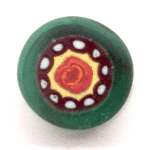
The working properties of this glass are different from those of the other coloured glasses with which it is usually combined (except, perhaps, yellow). In common with opaque yellow, the high amount of lead lowers the working temperatures, bringing the gathering temperature down from 1100°C for a normal Roman soda-lime-silica glass to 1000°C or less. Copper appears to have a similar effect, rendering the red glass far less viscous than yellow glass at the same temperature. This makes it difficult to work both of these glasses in pots in the same furnace as other glasses: either red and yellow are too runny or the other colours are too stiff. This forms a good argument for dedicated furnaces being used by the ancient glassmakers. [A further argument for the use of a separate furnace for yellow glass is that lead antimonate is unstable, gradually dissassociating and turning the yellow paler. Working at as low a temperature as possible slows this process.] The annealing temperature is also lower, but as the amounts used are small they appear to anneal sufficiently during the slow cool phase of the annealing cycle we use for our soda-lime glass.
Working with this red glass is not easy, and one has to adapt to the lower working temperatures. When combining red with any other glass, the glass temperature has to be hot enough to work that glass. This means that the red glass is very runny, and it has to be trapped and sealed between two layers of other glass. In effect, one is working with a bag of liquid, which wants to travel to one end or the other. Any holes in the "bag", and the glass will ooze out of them! On the rare occasions when red is used as the outer casing for a cane, it is very difficult to obtain a thick layer, and then to stretch both it and the rest of the glass together, as it will want to run off the end of the hot glass.
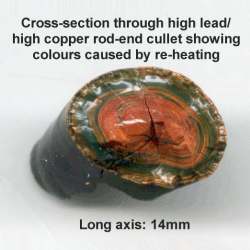
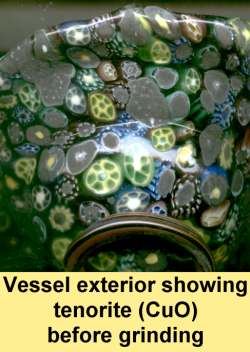
A further point with opaque red is that on contact with air, a thin, silver-black skin of cupric oxide (or "tenorite") forms on the surface of the hot glass. It will be reabsorbed if the glass is gathered over when making multi-coloured canes. When cold, this layer can be ground away to reveal the red underneath. It does have one very useful advantage: it prevents the red glass from running under the influence of gravity when a disc containing red is slumped.
Finally, this glass has to undergo heat treatment to encourage striking. In practice, the reheating occuring during fusing and slumping is enough to allow striking to red, but in the case of footrings, they have to be pre heat treated as they are not exposed to heat for long enough when being attached.
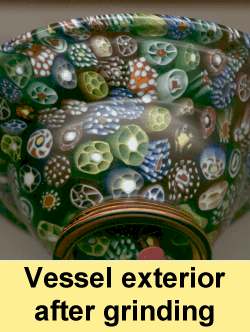
In use the colour is reasonably stable, and a melt of c.1.00kg can be worked over a period of several hours in a small open pot without any adverse effects on the final red colour. The glass is, however, less willing to turn orange or red on the reheats necessary for cane production. It will, instead, stay opaque green or turn yellow ochre. When cane-making using red, the final colour in the cane is often not red. It can be opaque green, yellow ochre or orange, depending on the amount of reheating it has had and the length of time the glass has been in a molten state. When included as part of a fused and slumped disc, it will turn red.
All of these considerations had to be addressed by ancient glassmakers, and can be regarded as part of a range of "hidden skills" that were necessary to produce mosaic glass, and shows their intimate knowledge of their materials.
Mark Taylor and David Hill
| vitrearii @ romanglassmakers . co . uk | 0044 (0)1264 889688 |
Unit 11, Project Workshops, Lains Farm, Quarley, Andover, Hampshire SP11 8PX, UK
 |
Our Open Weekend is on June 1st and 2nd. Entrance is £2-50, and there is ample parking space. All of the studios will be open, and there will be over 40 artists and craftspeople exhibiting. We will be displaying our mosaic glass, and will be available to discuss it. Please email us for more information.
Our website should be online in May. Try this link: www.romanglassmakers.co.uk |